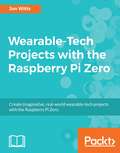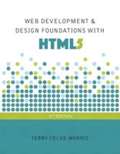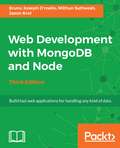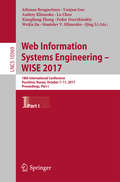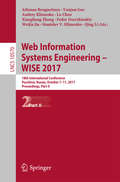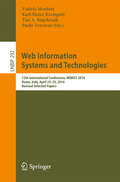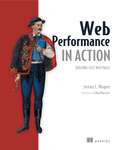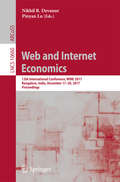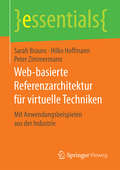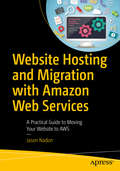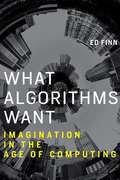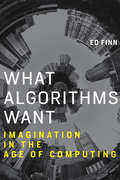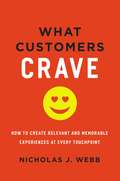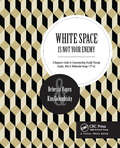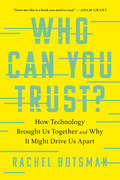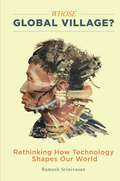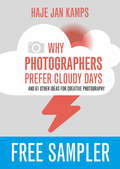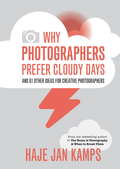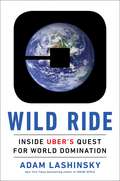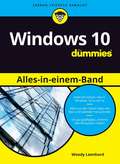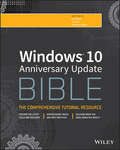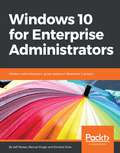- Table View
- List View
Wearable-Tech Projects with the Raspberry Pi Zero
by Jon WittsLeverage the cheapest and smallest computer to build exciting wearable-tech projects. About This Book • A practical and imaginative guide that exposes you to amazing wearable-tech projects • Create our own heart-rate monitor device and cool projects such as a Tweet-activated LED T-shirt • A practical guide packed with real-world, useful wearable-tech projects Who This Book Is For Everyone. While some prior knowledge of Python programming and use of the terminal on the Raspberry Pi would be advantageous, they are by no means necessary. Each chapter clearly sets the steps to be taken on your wearable-tech adventure. The first chapter assumes no prior knowledge to get your Pi Zero and you, up and running. The complexity of the electronic devices used, progress incrementally as you work through the chapters; there are clear steps to follow and pictures to help you at every turn along the way. What You Will Learn • Make use of your Raspberry Pi Zero to create wearable-tech projects • Interface with electronic devices and use Python to control them; incorporate these into real-world, practical, wearable-tech projects • Add LED devices to clothing and connect them to your Pi Zero • Change how LEDs react based upon your movement or messages sent through Twitter • Create a pedometer and heart rate monitor • Create your own GPS tracker In Detail With Wearable-Tech Projects with the Raspberry Pi Zero, you will begin with learning how to install the required software for your upcoming projects. You will also learn how to control electronic devices with the GPIOZero Python library. Next, you will be creating some stylish wearable-tech projects such as a motion-reactive LED cap and a Tweet-activated LED T-shirt. Toward the end of the book, you will be creating some useful health and fitness wearable-tech projects; these will help you monitor your heart rate, track your movements with GPS, and count your footsteps with your own pedometer. By the end of the book, you will have created a range of wearable-tech projects and learned enough about your Raspberry Pi Zero that you should be able to adapt these projects further or come up with your own creations! Style and approach This book showcases interesting and cool projects that use the Raspberry Pi Zero in wearable-tech. This book is for readers who are looking to progress to the next level of integrating hardware into their projects. Upon completion of each project, you will have a functional device that can be worn either to enhance your style or to provide you with practical data.
Web Development And Design Foundations With HTML5 (Eighth Edition)
by Terry Felke-MorrisUpdated and expanded in this Eighth Edition, Web Development and Design Foundations with HTML5 presents a comprehensive introduction to the development of effective web sites. Intended for beginning web developers, the text relates both the necessary hard skills (such as HTML5, CSS, and JavaScript) and soft skills (design, e-commerce, and promotion strategies) considered fundamental to contemporary web development. An emphasis on hands-on practice guides readers, as the text introduces topics ranging from configuration and layout to accessibility techniques and ethical considerations. The Eighth Edition contains updated coverage of HTML5 and CSS, expanded coverage of designing for mobile devices, and more.
Web Development with MongoDB and Node - Third Edition
by Jason Krol Mithun Satheesh Bruno Joseph D'MelloUse the two popular web development stacks, Node.js and MongoDB, to build full-featured web applications About This Book • Learn the new ECMAScript along with Node 8 and MongoDB to make your application more effective. • Get the up-to-date information required to launch your first application prototype using the latest versions of Node.js and MongoDB. • A practical guide with clear instructions to designing and developing a complete web application from start to finish using trending frameworks such as angular4 and hapi Who This Book Is For The book is designed for JavaScript developers of any skill level who want to get up-and-running using Node.js and MongoDB to build full-featured web applications. A basic understanding of JavaScript and HTML is the only prerequisite for this book. What You Will Learn • Work with Node.js building blocks • Write and configure a web server using Node.js powered by the Express.js framework • Build dynamic HTML pages using the Handlebars template engine • Persist application data using MongoDB and Mongoose ODM • Test your code using automated testing tools such as the Mocha framework • Automate test cases using Gulp • Reduce your web development time by integrating third-party tools for web interaction. • Deploy a development environment to the cloud using services such as Heroku, Amazon Web Services, and Microsoft Azure • Explore single-page application frameworks to take your web applications to the next level In Detail Node.js builds fast, scalable network applications while MongoDB is the perfect fit as a high-performance, open source NoSQL database solution. The combination of these two technologies offers high performance and scalability and helps in building fast, scalable network applications. Together they provide the power for manage any form of data as well as speed of delivery. This book will help you to get these two technologies working together to build web applications quickly and easily, with effortless deployment to the cloud. You will also learn about angular 4, which consumes pure JSON APOIs from a hapi server. The book begins by setting up your development environment, running you through the steps necessary to get the main application server up-and-running. Then you will see how to use Node.js to connect to a MongoDB database and perform data manipulations. From here on, the book will take you through integration with third-party tools to interact with web apps. You will see how to use controllers and view models to generate reusable code that will reduce development time. Toward the end, the book supplies tests to properly execute your code and take your skills to the next level with the most popular frameworks for developing web applications. By the end of the book, you will have a running web application developed with MongoDB, Node.js, and some of the most powerful and popular frameworks. Style and approach A practical guide with clear instructions to designing and developing a complete web application from start to finish
Web Information Systems Engineering – WISE 2017: 18th International Conference, Puschino, Russia, October 7-11, 2017, Proceedings, Part I (Lecture Notes in Computer Science #10569)
by Qing Li Athman Bouguettaya Weijia Jia Yunjun Gao Andrey Klimenko Lu Chen Xiangliang Zhang Fedor Dzerzhinskiy Stanislav V. KlimenkoThe two-volume set LNCS 10569 and LNCS 10570 constitutes the proceedings of the 18th International Conference on Web Information Systems Engineering, WISE 2017, held in Puschino, Russia, in October 2017. The 49 full papers and 24 short papers presented were carefully reviewed and selected from 195 submissions. The papers cover a wide range of topics such as microblog data analysis, social network data analysis, data mining, pattern mining, event detection, cloud computing, query processing, spatial and temporal data, graph theory, crowdsourcing and crowdsensing, web data model, language processing and web protocols, web-based applications, data storage and generator, security and privacy, sentiment analysis, and recommender systems.
Web Information Systems Engineering – WISE 2017: 18th International Conference, Puschino, Russia, October 7-11, 2017, Proceedings, Part II (Lecture Notes in Computer Science #10570)
by Qing Li Athman Bouguettaya Weijia Jia Yunjun Gao Andrey Klimenko Lu Chen Xiangliang Zhang Fedor Dzerzhinskiy Stanislav V. KlimenkoThe two-volume set LNCS 10569 and LNCS 10570 constitutes the proceedings of the 18th International Conference on Web Information Systems Engineering, WISE 2017, held in Puschino, Russia, in October 2017. The 49 full papers and 24 short papers presented were carefully reviewed and selected from 195 submissions. The papers cover a wide range of topics such as microblog data analysis, social network data analysis, data mining, pattern mining, event detection, cloud computing, query processing, spatial and temporal data, graph theory, crowdsourcing and crowdsensing, web data model, language processing and web protocols, web-based applications, data storage and generator, security and privacy, sentiment analysis, and recommender systems.
Web Information Systems and Technologies: 12th International Conference, WEBIST 2016, Rome, Italy, April 23–25, 2016, Revised Selected Papers (Lecture Notes in Business Information Processing #292)
by Valérie Monfort, Karl-Heinz Krempels, Tim A. Majchrzak and Paolo TraversoThis book constitutes revised selected papers from the 12th International Conference on Web Information Systems and Technologies, WEBIST 2016, held in Rome, Italy, April 23-25, 2016, organized by the Institute for Systems and Technologies of Information, Control and Communication (INSTICC). The purpose of the WEBIST series of conferences is to bring together researches, engineers and practitioners interested in technological advances and business applications of web-based information systems. The 9 full papers presented in this volume were carefully reviewed and selected originally 123 paper submissions. They contribute to the understanding of relevant trends of current research on Web Information Systems and Technologies, comprising recommender systems, sentiment analysis, ranking, and Web applications and Web architecture.
Web Performance in Action: Building Fast Web Pages
by Jeremy WagnerSummaryWeb Performance in Action is your companion guide to making websites faster. You'll learn techniques that speed the delivery of your site's assets to the user, increase rendering speed, decrease the overall footprint of your site, as well as how to build a workflow that automates common optimization techniques. Purchase of the print book includes a free eBook in PDF, Kindle, and ePub formats from Manning Publications.About the TechnologyNifty features, hip design, and clever marketing are great, but your website will flop if visitors think it's slow. Network conditions can be unpredictable, and with today's sites being bigger than ever, you need to set yourself apart from the competition by focusing on speed. Achieving a high level of performance is a combination of front-end architecture choices, best practices, and some clever sleight-of-hand. This book will demystify all these topics for you.About the BookWeb Performance in Action is your guide to making fast websites. Packed with "Aha!" moments and critical details, this book teaches you how to create performant websites the right way. You'll master optimal rendering techniques, tips for decreasing your site's footprint, and technologies like HTTP/2 that take your website's speed from merely adequate to seriously fast. Along the way, you'll learn how to create an automated workflow to accomplish common optimization tasks and speed up development in the process. What's InsideFoolproof performance-boosting techniquesOptimizing images and fontsHTTP/2 and how it affects your optimization workflowAbout the ReaderThis book assumes that you're familiar with HTML, CSS, and JavaScript. Many examples make use of Git and Node.js.About the AuthorJeremy Wagner is a professional front-end web developer with over ten years of experience. Foreword by Ethan Marcotte.Table of ContentsUnderstanding web performanceUsing assessment toolsOptimizing CSSUnderstanding critical CSSMaking images responsiveGoing further with imagesFaster fontsKeeping JavaScript lean and fastBoosting performance with service workersFine-tuning asset deliveryLooking to the future with HTTP/2Automating optimization with gulp
Web and Internet Economics: 13th International Conference, WINE 2017, Bangalore, India, December 17–20, 2017, Proceedings (Lecture Notes in Computer Science #10660)
by Nikhil R. Devanur and Pinyan LuThis book constitutes the thoroughly refereed proceedings of the 13th International Conference on Web and Internet Economics, WINE 2017, held in Bangalore, India, in December 2017. The 28 full and 6 short papers presented were carefully reviewed and selected from 89 submissions. The papers reflect the work of researchers in theoretical computer science, artificial intelligence, and microeconomics who have joined forces to tackle problems at the intersection of computation, game theory and economics.
Web-basierte Referenzarchitektur für virtuelle Techniken: Mit Anwendungsbeispielen aus der Industrie (essentials)
by Sarah Brauns Hilko Hoffmann Peter ZimmermannIn diesem essential zum Verbundprojekt ARVIDA wird von den Autoren die zunehmende Bedeutung der Virtuellen Techniken (VT) in der industriellen Produktentwicklung und Produktionsplanung prägnant und in Kürze beschrieben. Als Resultat der neuen, vielfältigen Anforderungen, die sich aus den Entwicklungen rund um Industrie 4.0 ergeben, wird eine erheblich flexiblere Gestaltung von VT-Systemen notwendig. Der gewählte Ansatz nutzt etablierte, dienstorientierte Web-Technologien sowie Konzepte aus dem Semantic Web zum Aufbau einer offenen Referenzarchitektur. Diese wurden in industriellen Anwendungsszenarien in Hinblick auf Interoperabilität, Systemperformanz und Transparenz bei der Anwendungsentwicklung evaluiert.
Website Hosting and Migration with Amazon Web Services
by Jason NadonUnderstand the steps necessary to host your website using the Amazon Web Services (AWS) platform. You will be able to set up your website for the first time or migrate your existing website. Explore scenarios, considerations, and steps for three types of websites, including hosting a static website, a content management system (CMS) based website, and a full-featured enterprise level website. Topic areas such as content storage in S3, compute resources in EC2, Route53 DNS Management, email services setup using Simple Email Service as well as strategies for high availability, fault tolerance, and website maintenance are covered. Website Hosting and Migration with Amazon Web Services is organized in a way that allows you to start with simple concepts using AWS core services that allow you to build knowledge and confidence using AWS services while exploring the latest technology on this ever-updating platform. Using AWS to host your website offers you more control over your infrastructure, content delivery, and ability to scale to fit your website needs. It's time to take control and take your website to the next level. This engaging resource: Explains how to use the Amazon Web Services Free Tier to evaluate the platform for hosting your website Walks you through the setup and migration steps for three unique and popular web hosting scenarios Delivers hands-on experience with base concepts that can be built upon to grow and improve your website infrastructure Provides sample resources to test and understand the setup process fully What You'll Learn Evaluate Amazon Web Services (AWS) offered on the platform that may benefit your website Set up and maintain three unique types of websites using AWS core services, enabling you to gain a deeper understanding of what is capable for your website or future projects Select AWS services that can improve performance and control of your website Manage DNS, domain registration, and transfers in AWS Use CloudFront to deliver content efficiently on a global scale Use AWS RDS to deliver a redundant database solution for your website Who This Book Is For Small business owners, webmasters, freelance web designers, and others looking to have more control over their web content, save money by using a platform that charges for just the services you use, or grow the stability of their website by making it highly available, fault tolerant, and easily deployed; those looking to learn more about AWS Web Hosting options in general
What Algorithms Want: Imagination in the Age of Computing
by Ed FinnWe depend on -- we believe in -- algorithms to help us get a ride, choose which book to buy, execute a mathematical proof. It's as if we think of code as a magic spell, an incantation to reveal what we need to know and even what we want. Humans have always believed that certain invocations -- the marriage vow, the shaman's curse -- do not merely describe the world but make it. Computation casts a cultural shadow that is shaped by this long tradition of magical thinking. In this book, Ed Finn considers how the algorithm -- in practical terms, "a method for solving a problem" -- has its roots not only in mathematical logic but also in cybernetics, philosophy, and magical thinking. Finn argues that the algorithm deploys concepts from the idealized space of computation in a messy reality, with unpredictable and sometimes fascinating results. Drawing on sources that range from Neal Stephenson's Snow Crash to Diderot's Encyclopédie, from Adam Smith to the Star Trek computer, Finn explores the gap between theoretical ideas and pragmatic instructions. He examines the development of intelligent assistants like Siri, the rise of algorithmic aesthetics at Netflix, Ian Bogost's satiric Facebook game Cow Clicker, and the revolutionary economics of Bitcoin. He describes Google's goal of anticipating our questions, Uber's cartoon maps and black box accounting, and what Facebook tells us about programmable value, among other things.If we want to understand the gap between abstraction and messy reality, Finn argues, we need to build a model of "algorithmic reading" and scholarship that attends to process, spearheading a new experimental humanities.
What Algorithms Want: Imagination in the Age of Computing
by Ed FinnThe gap between theoretical ideas and messy reality, as seen in Neal Stephenson, Adam Smith, and Star Trek. We depend on—we believe in—algorithms to help us get a ride, choose which book to buy, execute a mathematical proof. It's as if we think of code as a magic spell, an incantation to reveal what we need to know and even what we want. Humans have always believed that certain invocations—the marriage vow, the shaman's curse—do not merely describe the world but make it. Computation casts a cultural shadow that is shaped by this long tradition of magical thinking. In this book, Ed Finn considers how the algorithm—in practical terms, “a method for solving a problem”—has its roots not only in mathematical logic but also in cybernetics, philosophy, and magical thinking. Finn argues that the algorithm deploys concepts from the idealized space of computation in a messy reality, with unpredictable and sometimes fascinating results. Drawing on sources that range from Neal Stephenson's Snow Crash to Diderot's Encyclopédie, from Adam Smith to the Star Trek computer, Finn explores the gap between theoretical ideas and pragmatic instructions. He examines the development of intelligent assistants like Siri, the rise of algorithmic aesthetics at Netflix, Ian Bogost's satiric Facebook game Cow Clicker, and the revolutionary economics of Bitcoin. He describes Google's goal of anticipating our questions, Uber's cartoon maps and black box accounting, and what Facebook tells us about programmable value, among other things.If we want to understand the gap between abstraction and messy reality, Finn argues, we need to build a model of “algorithmic reading” and scholarship that attends to process, spearheading a new experimental humanities.
What Customers Crave: How to Create Relevant and Memorable Experiences at Every Touchpoint
by Nicholas WebbThink you know your customers? You better be more assured than just thinking you do, because your success depends on it! The best companies in the world first research exhaustively what their customers desire, and then they deliver it in memorable and deeply human experiences--resulting in success previously believed to be unachievable. So once again, how well do you know your customers?In a hyperconnected economy that is radically changing consumer expectations, this vital expectation for any successful business is not always easy. But in What Customers Crave, author and business strategist Nicholas Webb simplifies this critical task into being able to confidently answer two questions: What do your customers love? What do they hate?Jam-packed with tools and examples, this must-have resource helps businesses reinvent how they engage with customers (both physical and virtual). Learn how to:• Gain invaluable insights into who your customers are and what they care about• Use listening posts and Contact Point Innovation to refine customer types• Engineer experiences for each micromarket that are not only exceptional, but insanely relevant• Connect across the five most important touchpoints• Co-create with your customers• And more!It’s time to reinvent the ways you engage with your customers. Because when you learn to provide for them exactly what they want, they not only bring along their wallets but those belong to their friends as well!
When Lava Strikes: An Unofficial Minecrafters Novel (Secrets of an Overworld Survivor #2)
by Grace Sandford Greyson MannWhen Will and Mina discover an abandoned mine shaft, they quickly plan a treasure hunt. The two friends dream of the riches they’ll unearth together and can’t wait to get started, but they quickly discover that they very different ideas about what treasure is! Torn between searching for mobs and potion supplies and seeking out the chest at the heart of the mine, the duo is on the verge of splitting up.But then a trio of treasure hunters challenge Will and Mina, and a poorly aimed pickaxe puts everyone in the mine in danger. As the chambers around them fill with lava and their hunt for treasure becomes a fight for survival, can Will and Mina put their differences aside and work together to escape with their lives?Every chapter of this second installment in the Secrets of an Overworld Survivor chapter book series is packed with adventure-perfect for introducing young gamers to reading!Sky Pony Press, with our Good Books, Racehorse and Arcade imprints, is proud to publish a broad range of books for young readers-picture books for small children, chapter books, books for middle grade readers, and novels for young adults. Our list includes bestsellers for children who love to play Minecraft; stories told with LEGO bricks; books that teach lessons about tolerance, patience, and the environment, and much more. While not every title we publish becomes a New York Times bestseller or a national bestseller, we are committed to books on subjects that are sometimes overlooked and to authors whose work might not otherwise find a home.
White Space Is Not Your Enemy: A Beginner's Guide to Communicating Visually Through Graphic, Web & Multimedia Design
by Kim Golombisky Rebecca HagenWhite Space Is Not Your Enemy is a practical graphic design and layout guide that introduces concepts and practices necessary for producing effective visual communication across a variety of formats—from web to print. Sections on Gestalt theory, color theory, and WET layout are expanded to offer more in-depth content on those topics. This new edition features new covering current trends in web design—Mobile-first, UI/UX design, and web typography—and how they affect a designer’s approach to a project. The entire book will receive an update using new examples and images that show a more diverse set of graphics that go beyond print and web and focus on tablet, mobile and advertising designs.
Who Can You Trust?: How Technology Brought Us Together and Why It Might Drive Us Apart
by Rachel BotsmanIf you can't trust those in charge, who can you trust?From government to business, banks to media, trust in institutions is at an all-time low. But this isn't the age of distrust--far from it.In this revolutionary book, world-renowned trust expert Rachel Botsman reveals that we are at the tipping point of one of the biggest social transformations in human history--with fundamental consequences for everyone. A new world order is emerging: we might have lost faith in institutions and leaders, but millions of people rent their homes to total strangers, exchange digital currencies, or find themselves trusting a bot. This is the age of "distributed trust," a paradigm shift driven by innovative technologies that are rewriting the rules of an all-too-human relationship.If we are to benefit from this radical shift, we must understand the mechanics of how trust is built, managed, lost, and repaired in the digital age. In the first book to explain this new world, Botsman provides a detailed map of this uncharted landscape--and explores what's next for humanity.
Whose Global Village?: Rethinking How Technology Shapes Our World
by Ramesh SrinivasanThis critical reassessment of digital proliferation calls for a new approach to technology that includes marginalized, non-western communities. In the digital age, technology has shrunk the physical world into a &“global village,&” where we all seem to be connected as an online community. Yet while we think of platforms such as Twitter and Facebook as open and accessible to all, they are in fact commercial entities developed primarily by and for the Western world. Considering how new technologies increasingly shape labor, economics, and politics, these tools often reinforce the inequalities of globalization, rarely reflecting the perspectives of those at the bottom of the digital divide. This book asks us to re-consider &‘whose global village&’ we are shaping with the digital technology revolution. Sharing stories of collaboration with Native Americans in California and New Mexico, revolutionaries in Egypt, communities in rural India, and others across the world, Ramesh Srinivasan urges us to re-imagine what the Internet, mobile phones, or social media platforms may look like when considered from the perspective of diverse cultures. Collaboration with maginalized communities could pave the way for a people-first approach toward designing and working with new technology worldwide.
Why Photographers Prefer Cloudy Days: Surprising And Inspiring Tips For Photographers
by Haje Jan Kamps**FREE SAMPLER** There's no one secret to taking beautiful photos, but good photographers build up a series of useful bits of know-how. They know that clouds, far from ruining a photo, give a great soft natural light for portraits. They know that unusual angles draw the eye, and that their feet are just as effective as a zoom lens.This book packs 62 of the most important creative ideas into one easy-to-read location, beautifully presented with example photos. None of these ideas need an expensive camera, fancy lens or a over-priced flash. The purpose of this book is to help you tell stories with your camera, whatever the camera.Whether you're photographing that perfect sunset or your morning coffee, Why Photographers Prefer Cloudy Days will show you how to capture it to best effect, whether you want it to look great on your Instagram, or amazing on your wall.
Why Photographers Prefer Cloudy Days: Surprising And Inspiring Tips For Photographers
by Haje Jan KampsThere's no one secret to taking beautiful photos. But good photographers do have a few tricks up theirsleeves... They know that clouds, far from ruining a photo, give a great soft natural light for portraits. They know that unusual angles draw the eye, and that their feet are just as effective as a zoom lens.This book packs 62 of the most important creative ideas into one place. Beautifully presented, easy-to-read and packed with example photos. None of these ideas need an expensive camera, fancy lens or a over-priced flash. The purpose of this book is to help you tell stories with your camera (or phone).Whatever you want to shoot, Why Photographers Prefer Cloudy Days is packed full of ideas to inspire you, and tips that will help you take better, more original photos.
Why Photographers Prefer Cloudy Days: and 61 Other Ideas for Creative Photography
by Haje Jan KampsThere's no one secret to taking beautiful photos. But good photographers do have a few tricks up theirsleeves... They know that clouds, far from ruining a photo, give a great soft natural light for portraits. They know that unusual angles draw the eye, and that their feet are just as effective as a zoom lens.This book packs 62 of the most important creative ideas into one place. Beautifully presented, easy-to-read and packed with example photos. None of these ideas need an expensive camera, fancy lens or a over-priced flash. The purpose of this book is to help you tell stories with your camera (or phone).Whatever you want to shoot, Why Photographers Prefer Cloudy Days is packed full of ideas to inspire you, and tips that will help you take better, more original photos.
Wicked Torture: A dramatically passionate love story
by J. KennerFrom J. Kenner, the New York Times and No. 1 international bestselling author of the million-copy selling Stark series, comes Wicked Torture, a new novel set in the seductive Stark world. For fans of Fifty Shades of Grey, Sylvia Day, Meredith Wild and Jodi Ellen Malpas.Outwardly, Noah Carter is riding high as the tech world's hottest new genius. Inside, he's still reeling from the abduction of his wife and baby daughter eight years ago, and then the devastating discovery of his child's body. For years, he kept up hope that his wife was alive, but now that she's been declared legally dead, he's thrown himself even more deeply into his work, cutting himself off from emotional ties because they just hurt too damn much.Then he meets Kiki Porter, an eternal optimist with a killer work ethic and dreams of fronting a band. And everything changes. Even though he tries his damnedest to fight it...Sexually, they are combustible together. But their true fire is emotional, though it is a slow to burn. But once it lights, it is all consuming. The relationship grows emotionally, the sex is hot, things are good.But just when it's looking like they might have a real future together, the past comes back to haunt them. And Noah's going to have to decide what he's willing to give up for love...Spellbinding romance. Electrifying passion. Why not indulge in J. Kenner...
Wild Ride: Inside Uber's Quest for World Domination
by Adam LashinskyIn your pocket is something amazing: a quick and easy way to summon a total stranger who will take you anywhere you’d like. In your hands is something equally amazing: the untold story of Uber’s meteoric rise, and the massive ambitions of its larger-than-life founder and CEO.Before Travis Kalanick became famous as the public face of Uber, he was a scrappy, rough-edged, loose-lipped entrepreneur. And even after taking Uber from the germ of an idea to a $69 billion global transportation behemoth, he still describes his company as a start-up. Like other Silicon Valley icons such as Steve Jobs and Elon Musk, he’s always focused on the next disruptive innovation and the next world to conquer.Both Uber and Kalanick have acquired a reputation for being combative, relentless, and iron-fisted against competitors. They’ve inspired both admiration and loathing as they’ve flouted government regulators, thrown the taxi industry into a tailspin, and stirred controversy over possible exploitation of drivers. They’ve even reshaped the deeply ingrained consumer behavior of not accepting a ride from a stranger—against the childhood warnings from everyone’s parents. Wild Ride is the first truly inside look at Uber’s global empire. Veteran journalist Adam Lashinsky, the bestselling author of Inside Apple, traces the origins of Kalanick’s massive ambitions in his humble roots, and he explores Uber’s murky beginnings and the wild ride of its rapid growth and expansion into different industries.Lashinsky draws on exclusive, in-depth interviews with Kalanick and many other sources who share new details about Uber’s internal and external power struggles. He also examines its doomed venture into China and the furtive fight between Kalanick and his competitors at Google, Tesla, Lyft, and GM over self-driving cars. Lashinsky even got behind the wheel as an Uber driver himself to learn what it’s really like.Uber has made headlines thanks to its eye-popping valuations and swift expansion around the world. But this book is the first account of how Uber really became the giant it is today, and how it plans to conquer the future.
Windows 10 Alles-in-einem-Band für Dummies (Für Dummies)
by Woody LeonhardWenn Sie Ihren Computer gerade auf Windows 10 umgestellt oder einen neuen Computer mit Windows 10 ausgepackt haben und ein zuverlässiges, umfassendes und verständliches Handbuch brauchen, dann ist dieses Buch genau richtig für Sie. Das Buch bahnt Ihnen den Weg durch das Fachkauderwelsch und deckt alles ab, was Power-User wissen müssen, inklusive der Navigation im Startmenü, des Sicherheitsmanagements und der Personalisierung der Windows-Funktionen. Sie erfahren, wie Sie Benutzerkonten für mehrere Nutzer einrichten, wie Sie ein Heimgruppennetzwerk aufbauen, in dem Sie Geräte teilen können, wie Sie maximalen Nutzen aus den Windows-Apps ziehen und wie Sie mit den üblichen Windows 10-Problemen fertig werden. Egal ob Sie Windows 10 beruflich oder privat nutzen, dieses Handbuch macht Ihnen den Umgang mit dem Computer leicht.
Windows 10 Anniversary Update Bible
by Jim Boyce Rob Tidrow Jeffrey R. ShapiroYour all-inclusive guide to Windows 10 Anniversary Edition Windows 10 Bible, Anniversary Update presents the ultimate reference for enterprise and professional Windows 10 Anniversary Update users. From setup and settings to networking and the daily workflow, this book provides expert guidance on all aspects of the OS. Read from beginning to end for a comprehensive tour of all of the nooks and crannies, or dip in as needed to find quick answers to your most pressing issues—formatted as a reference divided into mini-tutorials, this guide delves deep into the Windows 10 Anniversary Update to walk you through every inch of functionality. Personalize your settings, desktop, and security to augment the way you work; configure Windows 10 for enterprise with remote access, groups, and Hyper-V; set up a private network for two or 20 computers, and manage security to keep your content safe—everything you need to know is explained here. This book provides clear, authoritative guidance toward every aspect of the old and new to help you take advantage of everything Windows 10 Anniversary Update has to offer. Customize your Windows 10 Anniversary Update experience Install and remove hardware and software Set up your network and configure security Manage content, connect to printers, and troubleshoot issues Clear your to-do list faster than ever with Cortana voice commands, Windows Ink, Windows Hello, and a cross-platform capability that allows you to integrate a range of platforms including tablets, phones, Raspberry Pi, and even Xbox. Even if you're an experienced user, you're probably missing out on some very cool features—let the Windows 10 Bible, Anniversary Update fill the gaps and take your Windows 10 experience to the next level.
Windows 10 for Enterprise Administrators
by Jeff Stokes Manuel Singer Richard DiverLearn the art of configuring, deploying, managing and securing Windows 10 for your enterprise. About This Book • Enhance your enterprise administration skills to manage Windows 10 Redstone 3 • Get acquainted with configuring Azure Active Directory for enabling cloud-based services and Remote Server Admin Tools for managing Windows Server • Provide enterprise-level security with ease using the built-in data loss prevention of Windows 10 Who This Book Is For If you are a system administrator who has been given the responsibility of administering and managing Windows 10 Redstone 3, then this book is for you. If you have deployed and managed previous versions of Windows, it would be an added advantage. What You Will Learn • Understand the remote access capabilities • Use third-party tools to deploy Windows 10 • Customize image and user Interface experience • Implement assigned access rights • Configure remote administration • Manage Windows 10 security • Work with Azure AD and Intune management In Detail Microsoft's launch of Windows 10 is a step toward satisfying the enterprise administrator's needs for management and user experience customization. This book provides the enterprise administrator with the knowledge needed to fully utilize the advanced feature set of Windows 10 Enterprise. This practical guide shows Windows 10 from an administrator's point of view. You'll focus on areas such as installation and configuration techniques based on your enterprise requirements, various deployment scenarios and management strategies, and setting up and managing admin and other user accounts. You'll see how to configure Remote Server Administration Tools to remotely manage Windows Server and Azure Active Directory. Lastly, you will learn modern Mobile Device Management for effective BYOD and how to enable enhanced data protection, system hardening, and enterprise-level security with the new Windows 10 in order to prevent data breaches and impede attacks. By the end of this book, you will know the key technologies and capabilities in Windows 10 and will confidently be able to manage and deploy these features in your organization. Style and approach This step-by-step guide will show you how to configure, deploy, manage, and secure the all new Windows 10 Redstone 3 for your enterprise.
